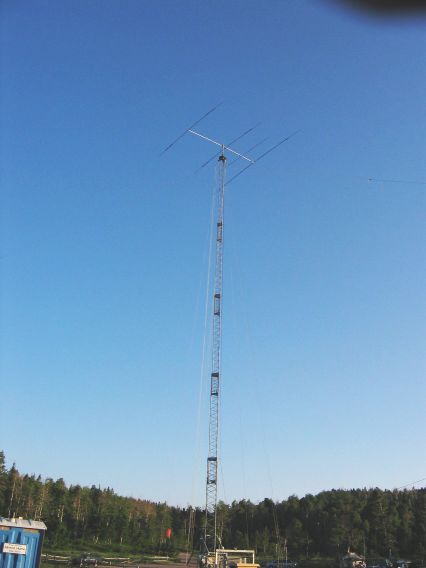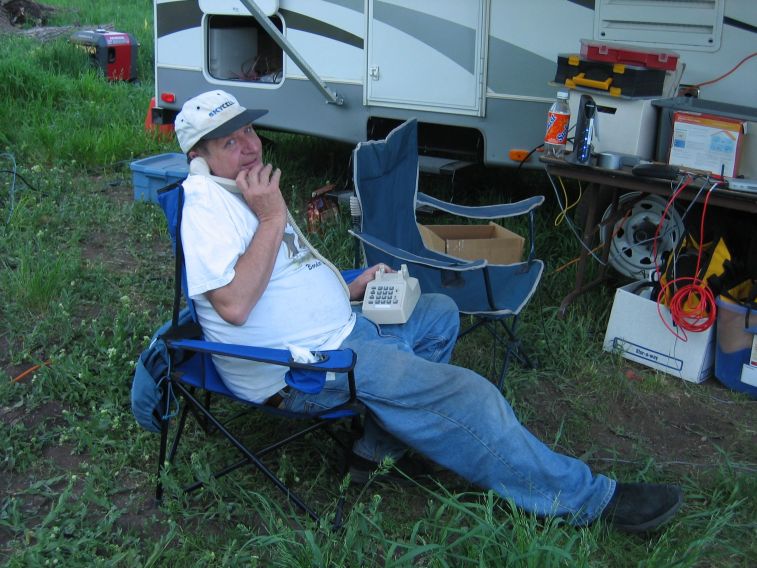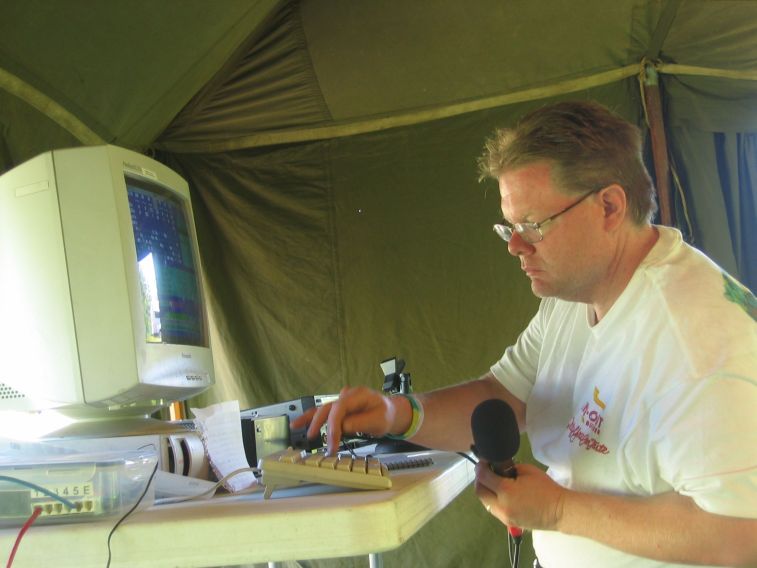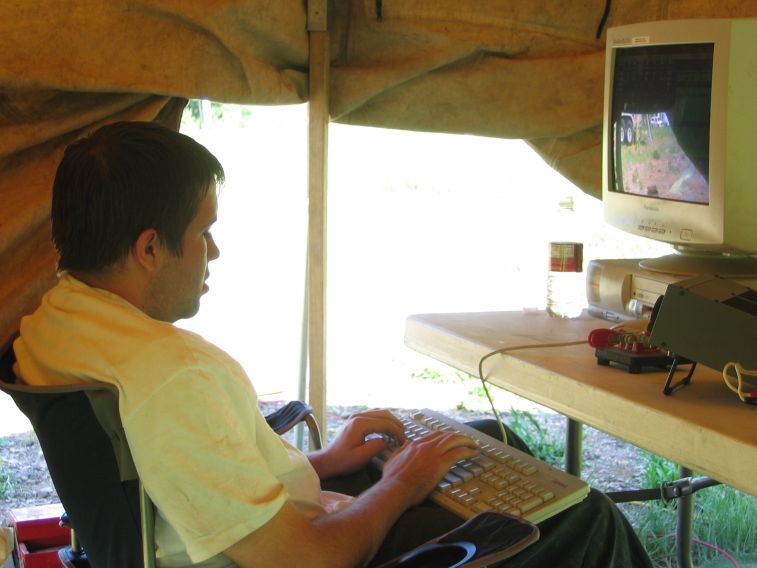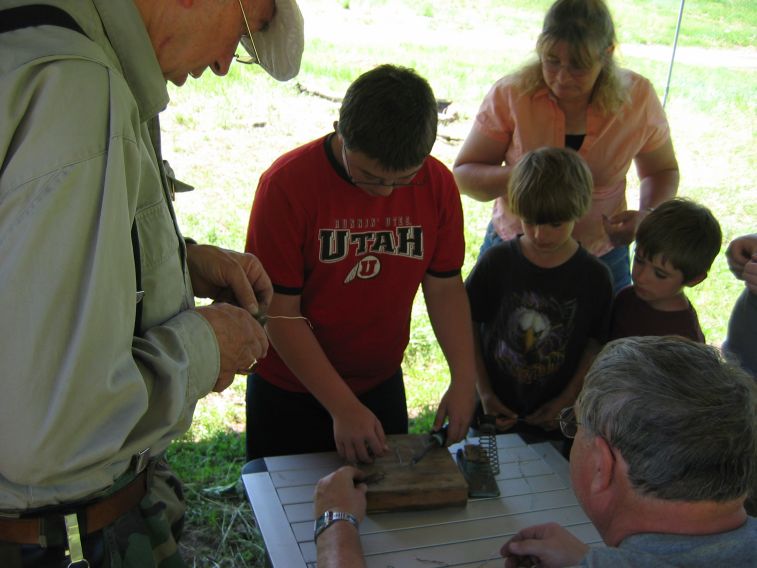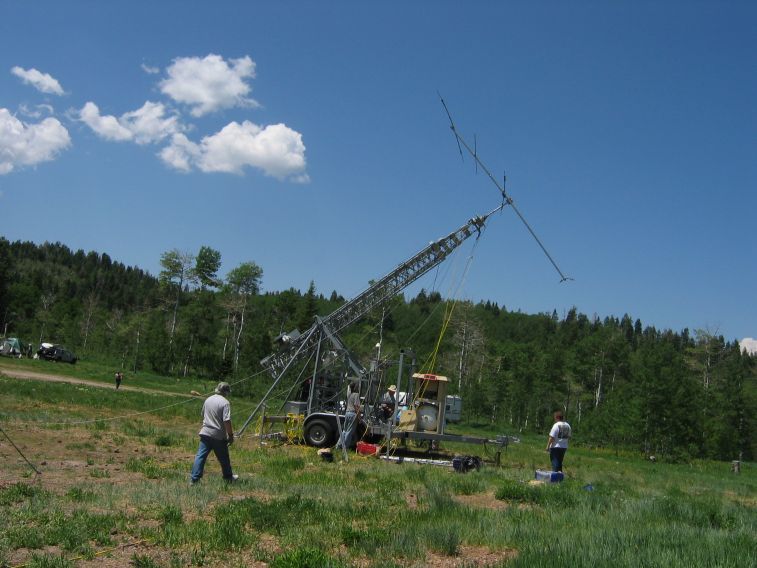Field Day Fans Find Friendly Field
UARC's 2008 Field Day Effort
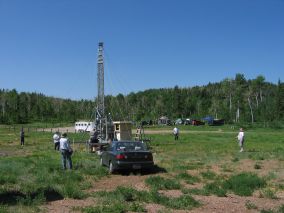 |
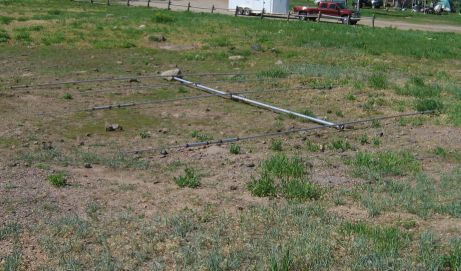 |
| We have a tower... | and a beam... |
| What's
missing? (Click on an image for a larger version) | |
It was time for the big event: Field Day, amateur radio's
biggest operating event of the year. (As far as we can
tell, this operating event is very similar to a contest.)
At least one ham, Scott, K7DXZ, had been camping on the
site of the UARC entry for a full week prior to Field Day
weekend, June 28 and 29. By Thursday night there seemed to be more
than a smattering of tents and trailers sprouting odd antennas
in the clearing just south of Payson Lakes.
Now it was Saturday morning, time to set up stations in order to be ready to operate by noon. Despite the early morning sighting of a bear near the southwest corner of the clearing, everyone was ready to get underway. We had the tower and the beam ready, but one item seemed to be missing: the rotor. This was to be the first of several manifestations of “Murphy's Law,” the rule which states “If anything can possibly go wrong, it will.” Andrew Madsen, AC7CF, had (perhaps by undisclosed torture threats) agreed to be Field Day Chairman this year. Fortunately, Andrew had a friend coming in from Logan who could stop by the club's storage shed and perform a last-minute rescue by bringing up the club's rotor.
Murphy seemed to have intervened in other areas too. There had been no one able to carry up a second tower for the second Yagi, there weren't enough stakes for one of the operating tents, the CW computer interface that had worked fine in 2007 refused to repeat the feat in 2008, and there was no balun for one of the antennas fed with window line. But, hey, isn't Field Day all about improvising? What better simulation of an emergency could we have?
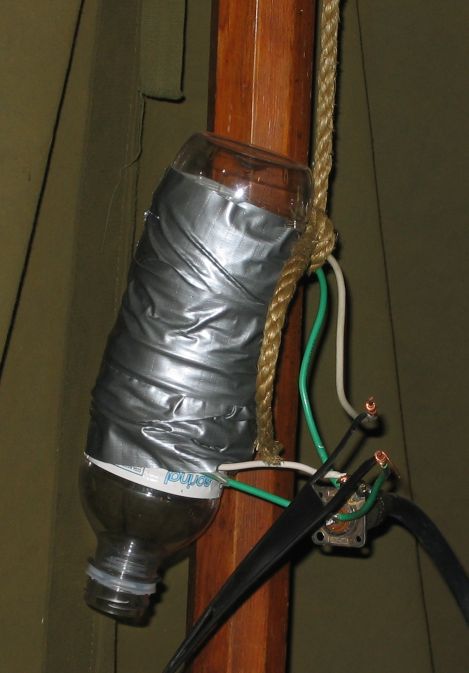 | |
| WA7X's “Bottle Balun,” the economy solution to feeding balanced lines. |
Traditionally, the CW station is the big point-getter on Field Day, not only because CW contacts count twice as much as phone contacts, but also because it just seems possible to make the QSOs faster. But part of the efficiency comes from being able to use the same computer to log and to send code, so fixing the computer interface delayed our getting on by at least a couple of hours. It turned out that Andrew had an NPN transistor and Glen, WA7X, had a 1K resistor, and that was all we needed to replace the relay circuit with an all-electronic version. (Fortunately, there were no grid-block-keyed rigs this year.)
Glen also helped out solving the balun problem by winding a bifilar coil on a water bottle. We don't know if the brand of spring water is important, but the device seemed to work just fine. (Perhaps the “Bottle Balun” will appear in future editions of the ARRL Handbook.)
The original plan had been to operate in the “3A” class (i.e. using three simultaneous transmitters), but when the antenna situation (one missing tower) was assessed and the number of potential operators counted, it was decided that 2A would be just fine. That gave us one phone station, one CW station, and one (free) “Get on the Air” (GOTA) station for new, potential, or inactive hams.
Once the CW station was going full-bore, another Murphyism appeared. When the phone and CW stations were both operating on 20 meters, they caused considerable mutual interference. Apparently the stations and/or the antennas were too close together. It's bad enough putting up with the QRM from other stations without having to generate your own, so we moved the phone station to 40 meters.
By dinnertime, things were running reasonably smoothly. Then, the miracle occurred. Despite the fact that only about a dozen potential operators had been found, the group was able to consume roast beef for 75 with no trouble at all. One of the long-standing traditions at UARC Field Days is that when it's dinnertime, the CW operator is the last to know. This tradition was followed closely this year until Glen, WA7X, had mercy on the author and brought a plate over to the operating tent.
Despite the fact that Saturday temperatures in the Salt Lake Valley approached the 100 mark, it gets chilly at the 8000-foot level after the sun goes down. Achim, NC6X, had come straight from a company party. He bravely operated CW for an hour or so in shorts and sandals before making a hasty retreat to warmer climes. Lonny, K7LO, fired up a robust propane heater in the phone tent, but the CW operators braved it with just the finals to warm things up.
When it was dark enough, Ron Speirs, K7RLS, the club historian and photographer, put on a slide-show featuring Field Days from several previous years. It's always hoped that the current situation won't seem as bad as we look at Murphy appearances from the past.
Operation continued through the evening and into the wee hours. There seemed to be many more class “D” and “E” stations (home stations) than we remembered from previous years. Perhaps a result of fuel prices? One station sent us his class as “23A.” Twenty-three simultaneous transmitters? We don't doubt it, but still would like to know where they found 23 productive bands.
Andrew, AC7CF, undoubtedly was responsible for more contact points than anyone else, doing the lion's share of the CW operating. Clint, KA7OEI, operated the SSB station from about 3 A.M. to 8 A.M. at a good clip, making the most QSOs of any phone operator.
John Hardy, K7ALA, was the leading GOTA operator, easily making 50 percent more than the required 20 contacts for 20 bonus points.
We're not entirely sure who all operated the GOTA station. We would like to credit everyone in the log we submit. Anyone who operated (or whose children did) but did not put his name in the log, get in touch with K7HFV (582-2438).
Operators were even more scarce on Sunday morning than they had been on Saturday, but there were enough to keep on the air until the final gun at noon.
Lots of folks pitched in for the tear-down, and their efforts were greatly appreciated.
When it was all over, the author got to experience a new facet of Field Day — towing one of the porta-john trailers back down the canyon, one with a flakey hitch. With visions of the trailer breaking loose and passing me on one of the switchbacks, I hardly dared race down at great speed, especially on bumpy turns. I led a caravan including UARC President John Brewer, N7MFQ, with his motor home, and Susan Brewer, N7OVG, towing the twin to my trailer. I'm not sure if it was the length of our caravan, or the consequences of contacting one of our “special” trailers, but no one seemed inclined to pass us. What the heck; I'd always wanted to lead a parade!
So how did we do? We had a total score of 4,570, assuming ARRL doesn't disagree with too many of our claimed bonus points. (See tabulation at right.) That's a bit less than last year's 4,764, but that's to be expected considering we were operating in the 2A class (just two simultaneous transmitters) this year as opposed to 3A last year. If that score were inserted into last year's 2A listings it would put us at about the 80th percentile. (Oddly, it would be about a point higher if inserted in the 3A listings!) It's interesting to note that about 67% of our QSOs and about 81% of our QSO points were made on the CW station. Anyone who would like to learn the code and develop some proficiency could make a big contribution to our score in future years. However, the “Field Day Packet” from ARRL points out that the real success of Field Day has less to do with the total score than with how much learning took place. We hope some new operators got a chance to try out HF, to try out contesting, and to get some practice copying quickly and accurately. Special thanks should go to John and his family who did almost all the towing, including the “COW” (Communications on Wheels) trailer with the 80-foot tower, and replaced a bad tire and a bad battery on the COW. Thanks to all who helped and participated in various ways. Help us figure out how to do it even better next year. | |||||||||||||||||||||||||||||||||||||||||||||||||||||||||||||||||||||||||||||||||||||||||||||||||||||||||||||||||||||||||||
